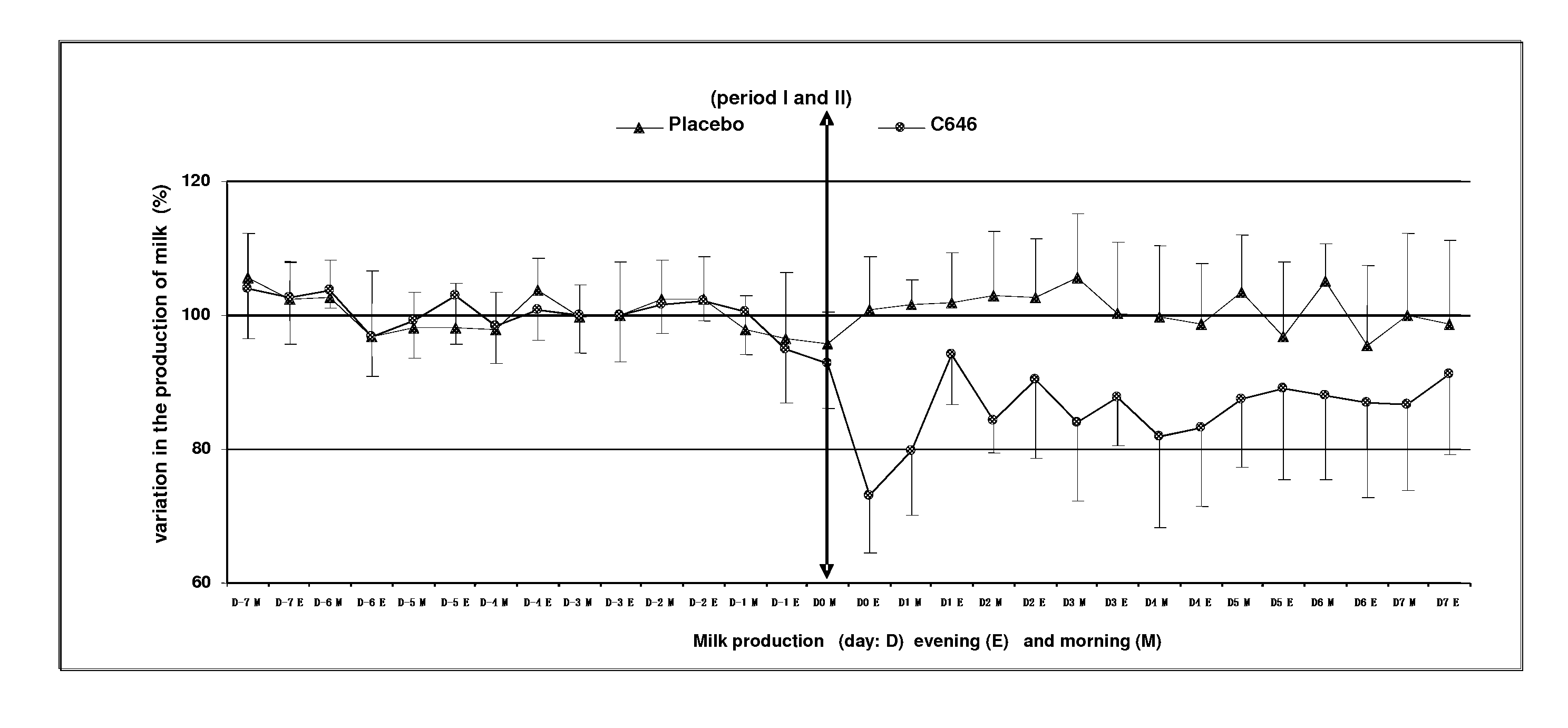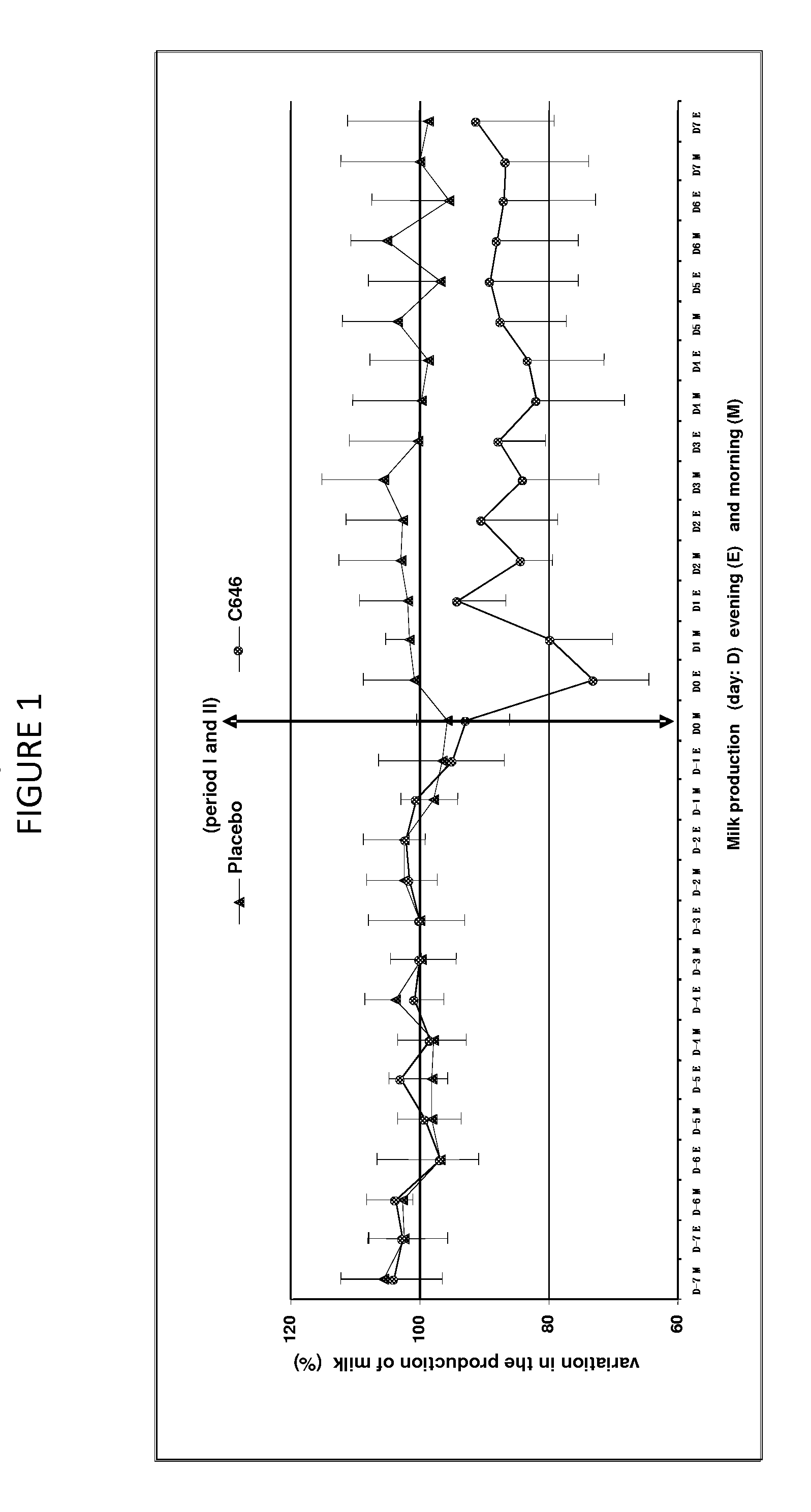Antiprolactinic veterinary composition for ruminants
a technology of ruminants and veterinary compositions, applied in the field of antiprolactinic veterinary compositions, can solve the problems of limiting the emergence of health-related troubles, and achieve the effects of reducing lactation, treating and/or preventing, and reducing the welfare of ruminants
- Summary
- Abstract
- Description
- Claims
- Application Information
AI Technical Summary
Benefits of technology
Problems solved by technology
Method used
Image
Examples
example 1
Preparation of Veterinary Compositions with a Cabergoline Base
[0056]Preparation of 9 liters of an injectable solution containing 500 mcg / ml of cabergoline.
Formula:
[0057]Active principle: 4.53 g of cabergoline (titrating 100%)[0058]Excipient: triglycerides of a medium chain q. s. 9 I.
Step 1: 4.53 g of cabergoline and 1.5 kg medium chain triglycerides were measured in a recipient of adequate capacity, and then a mix was shaken with a magnetic shaker (500 turns per minute) for at least 60 minutes for complete dissolving.
Step 2: In a dry recipient, 5 kg medium chain triglycerides were measured, the flow of nitrogen and the mixer were set and then the cabergoline in a concentrated solution, obtained at step 1, was added to the recipient. The shaking was maintained for 30 minutes and then the volume was brought to a final volume of 9 liters by adding medium chain triglycerides. The shaking was still maintained for another 30 minutes and then solution was filtered under pressurized nitroge...
example 2
Clinical Study of the Efficiency of the Cabergoline Based Veterinary Compositions in Ruminants
[0059]This study aimed to evaluate the reduction of milk production in 8 multipare cows of the Prim Holstein family in lactation for 6 months. These cows were aged between 3 and 9 years and have a level of production varying between 20 and 31 kg per day at the start of this study. The study was organized according to a design of cross-over (2 treatments×2 periods).
[0060]The formulation was described in Example 1, containing 500 mcg / ml of cabergoline in injectable solution that was used in this study.
[0061]Treatment Test (C646): Injectable solution of cabergoline of 500 mcg / ml, 1 single intramuscular injection of a dose of 5 mcg / kg that is 1 ml for 100 kg of body weight.
[0062]Treatment Control (Placebo): water for the preparation of injectable, 1 intramuscular injection of a volume identical to that of the treatment test of about 1 ml for 100 kg.
[0063]The sequence of the treatment was random...
example 3
Clinical Study of the Safety of Cabergoline-Based Veterinary Compositions in Ruminants
[0069]This study aims to show the absence of risks such as abortions and fetus toxicity during the use of cabergoline in gestating ruminants even in the case of an overdose of cabergoline based veterinary compositions according to the regimen prescribed in the present invention. Groups of cows at different gestating stages receive the treatment at different doses:[0070]3 months of gestation (6 animals), dose of 15 mcg / kg—2 injections at an interval of 48 hours[0071]7 to 8 months of gestation: (5 animals), dose of 15 mcg / kg—2 injections at an interval of 48 hours[0072]6.5 to 7.5 months of gestation: (11 animals), dose of 25 mcg / kg—2 injections an interval of 48 hours[0073]The formulation described in the Example 1, containing 500 mcg / ml of cabergoline in injectable solution is used in this study.
[0074]Regular clinical exams were conducted during a period lasting from 7 days before the treatment to 1...
PUM
| Property | Measurement | Unit |
|---|---|---|
| time | aaaaa | aaaaa |
| volume | aaaaa | aaaaa |
| body weight | aaaaa | aaaaa |
Abstract
Description
Claims
Application Information
 Login to View More
Login to View More - R&D
- Intellectual Property
- Life Sciences
- Materials
- Tech Scout
- Unparalleled Data Quality
- Higher Quality Content
- 60% Fewer Hallucinations
Browse by: Latest US Patents, China's latest patents, Technical Efficacy Thesaurus, Application Domain, Technology Topic, Popular Technical Reports.
© 2025 PatSnap. All rights reserved.Legal|Privacy policy|Modern Slavery Act Transparency Statement|Sitemap|About US| Contact US: help@patsnap.com



